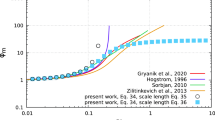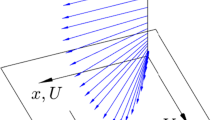Abstract
We propose a new turbulence closure model based on the budget equations for the key second moments: turbulent kinetic and potential energies: TKE and TPE (comprising the turbulent total energy: TTE = TKE + TPE) and vertical turbulent fluxes of momentum and buoyancy (proportional to potential temperature). Besides the concept of TTE, we take into account the non-gradient correction to the traditional buoyancy flux formulation. The proposed model permits the existence of turbulence at any gradient Richardson number, Ri. Instead of the critical value of Richardson number separating—as is usually assumed—the turbulent and the laminar regimes, the suggested model reveals a transitional interval, \(0.1 < {\rm Ri} < 1\) , which separates two regimes of essentially different nature but both turbulent: strong turbulence at \({\rm Ri} \ll 1\) ; and weak turbulence, capable of transporting momentum but much less efficient in transporting heat, at \({\rm Ri} > 1\) . Predictions from this model are consistent with available data from atmospheric and laboratory experiments, direct numerical simulation and large-eddy simulation.
Similar content being viewed by others
References
Agrawal A, Djenidi L, Antobia RA (2004) URL http://in3.dem.ist.utl.pt/lxlaser2004/pdf/paper_28_1.pdf
Banta RM, Newsom RK, Lundquist JK, Pichugina YL, Coulter RL, Mahrt L (2002) Nocturnal low-level jet characteristics over Kansas during CASES-99. Boundary-Layer Meteorol 105:221–252
Baumert HZ, Peters H (2005) A novel two equation turbulence closure model for high Reynolds numbers. Part A: homogeneous, non-rotating, stratified shear layers. In: Baumert HZ, Simpson JH, Sündermann J (eds) Marine turbulence. theory, observations and models. Cambridge University Press, pp 14–30
Beare RJ, MacVean MK, Holtslag AAM, Cuxart J, Esau I, Golaz JC, Jimenez MA, KhairoudinovM, Kosovic B, Lewellen D, Lund TS, Lundquist JK, McCabe A, Moene AF, Noh Y, Raasch S, Sullivan P (2006) Anintercomparison of large eddy simulations of the stable boundary layer. Boundary-Layer Meteorol 118:247–272
Bertin F, Barat J, Wilson R (1997) Energy dissipation rates, eddy diffusivity, and the Prandtl number: an in situ experimental approach and its consequences on radar estimate of turbulent parameters. Radio Sci 32:791–804
Canuto VM, Minotti F (1993) Stratified turbulence in the atmosphere and oceans: a new sub-grid model. J Atmos Sci 50:1925–1935
Canuto VM, Howard A, Cheng Y, Dubovikov MS (2001) Ocean turbulence. Part I: one-point closure model - momentum and heat vertical diffusivities. J Phys Oceanogr 31:1413–1426
Cheng Y, Canuto VM, Howard AM (2002) An improvedmodel for the turbulent PBL. J Atmosph Sci 59:1550– 1565
Churchill SW (2002) A reinterpretation of the turbulent Prandtl number. Ind Eng Chem Res 41:6393–6401
Cuxart J, 23 co-authors (2006) Single-column model intercomparison for a stably stratified atmospheric boundary layer. Boundary-Layer Meteorol 118:273–303
Dalaudier F, Sidi C (1987) Evidence and interpretation of a spectral gap in the turbulent atmospheric temperature spectra. J Atmos Sci 44:3121–3126
Elperin T, Kleeorin N, Rogachevskii I (1996) Isotropic and anisotropic spectra of passive scalar fluctuations in turbulent fluid flow. Phys Rev E 53:3431–3441
Elperin T, Kleeorin N, Rogachevskii I, Zilitinkevich S (2002) Formation of large-scale semi-organized structures in turbulent convection. Phys Rev E 66:066305 (1–15)
Elperin T, Kleeorin N, Rogachevskii I, Zilitinkevich S (2006) Turbulence and coherent structures in geophysical convection. Boundary-Layer Meteorol 119:449–472
Esau IN, Zilitinkevich SS (2006) Universal dependences between turbulent and mean flowparameters in stably and neutrally stratified planetary boundary layers. Nonlin Proce Geophys 13:135–144
Foken T (2006) 50 years of the Monin–Obukhov similarity theory. Boundary-Layer Meteorol 119:431–447
Hanazaki H, Hunt JCR (1996) Linear processes in unsteady stably stratified turbulence. J Fluid Mech 318:303– 337
Hanazaki H, Hunt JCR (2004) Structure of unsteady stably stratified turbulence with mean shear. J Fluid Mech 507:1–42
Hunt JCR, Kaimal JC, Gaynor JE (1985) Some observations of turbulence in stable layers. Quart J Roy Meteorol Soc 111:793–815
Hunt JCR, Stretch DD, Britter RE (1988) Length scales in stably stratified turbulent flows and their use in turbulence models. In: Puttock JS (ed) Proc. I.M.A. Conference on “Stably Stratified Flow and Dense Gas Dispersion” Clarendon Press, pp 285–322
Holton JR (2004) An introduction to dynamic meteorology. Academic Press, New York 535 pp
Jacobitz FG, Rogers MM, Ferziger JH (2005) Waves in stably stratified turbulent flow. J Turbulence 6:1–12
Jin LH, So RMC, Gatski TB (2003) Equilibrium states of turbulent homogeneous buoyant flows. J Fluid Mech 482:207–233
Kaimal JC, Finnigan JJ (1994) Atmospheric boundary layer flows. Oxford University Press, New York, 289 pp
Keller K, Van Atta CW (2000) An experimental investigation of the vertical temperature structure of homogeneous stratified shear turbulence. J Fluid Mech 425:1–29
Kraus EB, Businger JA (1994) Atmosphere-ocean interaction. Oxford University Press, Oxford 362 pp
Kolmogorov AN (1941) Energy dissipation in locally isotropic turbulence. Doklady AN SSSR 32(1):19–21
Kondo J, Kanechika O,Yasuda N (1978) Heat andmomentum transfer under strong stability in the atmospheric surface layer. J Atmos Sci 35:1012–1021
Kurbatsky AF (2000) Lectures on turbulence. Novosibirsk State University Press, Novosibirsk
Luyten PJ, Carniel S, Umgiesser G (2002) Validation of turbulence closure parameterisations for stably stratified flows using the PROVESS turbulence measurements in the North Sea. J Sea Research 47:239–267
L’vov VS, Pomyalov A, Procaccia I, Zilitinkevich SS (2006) Phenomenology of wall bounded Newtonian turbulence. Phys Rev E 73:016303, 1–13
Mahrt L, Vickers D (2005) Boundary layer adjustment over small-scale changes of surface heat flux. Boundary- Layer Meteorol 116:313–330
Mauritsen T, Svensson G (2007) Observations of stably stratified shear-driven atmospheric turbulence at low and high Richardson numbers. J Atmos Sci 64:645–655
Mauritsen T, Svensson G, Zilitinkevich SS, Esau E, Enger L, Grisogono B (2007) A total turbulent energy closure model for neutrally and stably stratified atmospheric boundary layers. J Atmos Sci (In press)
Mellor GL, Yamada T (1974) A hierarchy of turbulence closure models for planetary boundary layers. J Atmos Sci 31:1791–1806
Moser RG, Kim J, Mansour NN (1999) Direct numerical simulation of turbulent channel flow up to Re=590. Phys Fluids 11:943–945
Monin AS, Obukhov AM (1954) Main characteristics of the turbulent mixing in the atmospheric surface layer. Trudy Geophys Inst AN SSSR 24(151):153–187
Monin AS, Yaglom AM (1971) Statistical fluid mechanics. Vol 1. MIT Press, Cambridge Massachusetts, 769 pp
Ohya Y (2001) Wind-tunnel study of atmospheric stable boundary layers over a rough surface. Boundary-Layer Meteorol 98:57–82
Ozmidov RV (1990) Diffusion of contaminants in the ocean. Kluwer Academic Publishers, Dordrecht The Netherlands, 283 pp
Poulos GS, Blumen W, Fritts DC, Lundquist JK, Sun J, Burns SP, Nappo C, Banta R, Newsom R, Cuxart J, Terradellas E, Balsley B, Jensen M (2002) CASES-99: a comprehensive investigation of the stable nocturnal boundary layer. Bull Amer Meteorol Soc 83:555–581
Rehmann CR, Hwang JH (2005) Small-scale structure of strongly stratified turbulence. J Phys Oceanogr 32:154–164
Rehmann CR, Koseff JR (2004) Mean potential energy change in stratified grid turbulence Dynamics Atmospheres Oceans. 37:271–294
Richardson LF (1920) The supply of energy from and to atmospheric eddies. Proc Roy Soc London A 97:354– 373
Rohr JJ, Itsweire EC, Helland KN, Van Atta CW (1988) Growth and decay of turbulence in a stably stratified shear flow. J Fluid Mech 195:77–111
Rotta JC (1951) Statistische theorie nichthomogener turbulenz. Z Physik 129:547–572
Schumann U, Gerz T (1995) Turbulent mixing in stably stratified sheared flows. J App Meteorol 34:33–48
Shih LH, Koseff JR, Ferziger JH, Rehmann CR (2000) Scaling and parameterization of stratified homogeneous turbulent shear flow. J Fluid Mech 412:1–20
Strang EJ, Fernando HJS (2001) Vertical mixing and transports through a stratified shear layer. J Phys Oceanogr 31:2026–2048
Stretch DD, Rottman JW, Nomura KK, Venayagamoorthy SK (2001) Transient mixing events in stably strati- fied turbulence, In: 14thAustralasian FluidMechanics Conference:Adelaide, Australia, 10–14 December 2001
Umlauf L (2005) Modelling the effects of horizontal and vertical shear in stratified turbulent flows. Deep-Sea Res 52:1181–1201
Umlauf L, Burchard H (2005) Second-order turbulence closure models for geophysical boundary layers. A review of recent work. Continental Shelf Res 25:725–827
Uttal T, Curry JA, McPhee MG, Perovich DK, 24 other co-authors (2002) Surface Heat Budget of the Arctic Ocean. Bull Amer Meteorol Soc 83:255–276
Weng W, Taylor P (2003) On modelling the one-dimensional Atmospheric Boundary Layer. Boundary-Layer Meteoro, present volume 107:371–400
Zilitinkevich S (2002) Third-order transport due to internal waves and non-local turbulence in the stably stratified surface layer. Quart J Roy Meteorol Soc 128:913–925
Zilitinkevich SS, Esau IN (2005) Resistance and heat/mass transfer laws for neutral and stable planetary boundary layers: old theory advanced and re-evaluated. Quart J Roy Meteorol Soc 131:1863–1892
Zilitinkevich SS, Esau IN (2007) Similarity theory and calculation of turbulent fluxes at the surface for the stably stratified atmospheric boundary layers. Boundary-Layer Meteorol (In press, present volume)
Zilitinkevich SS, Perov VL, King JC (2002) Near-surface turbulent fluxes in stable stratification: calculation techniques for use in general circulation models. Quart J Roy Meteorol Soc 128:1571–1587
Author information
Authors and Affiliations
Corresponding author
Rights and permissions
About this article
Cite this article
Zilitinkevich, S.S., Elperin, T., Kleeorin, N. et al. Energy- and flux-budget (EFB) turbulence closure model for stably stratified flows. Part I: steady-state, homogeneous regimes. Boundary-Layer Meteorol 125, 167–191 (2007). https://doi.org/10.1007/s10546-007-9189-2
Received:
Accepted:
Published:
Issue Date:
DOI: https://doi.org/10.1007/s10546-007-9189-2




